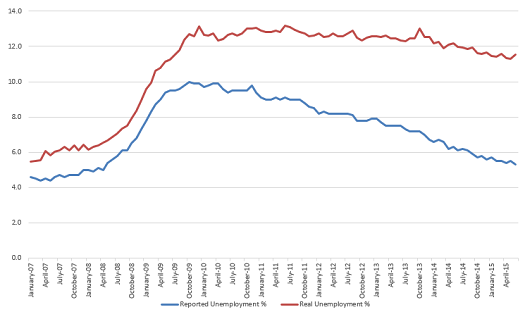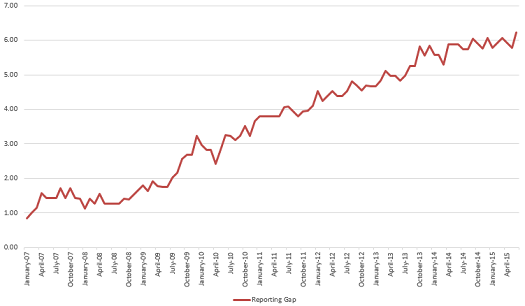The reality-bending nature of the reported unemployment figure in the United States hit a new high watermark, with the BLS today reporting that unemployment was at 5.3% when it actually spiked to 11.52%. They reported a decline of 0.2 points when it actually climbed 0.24 points. And while I am amazed and pleased that the media is at least starting to talk about labor-force participation rates when they report these statistics, no one in the mainstream is putting it in real figures that play ball with the types of figures that people expect to hear.
Unemployment in this country is actually over 11.5%. The gap between the reported figure and the real figure is a whopping 6.22%, an all-time high, or fully 117% of the reported rate! The last time the unemployment rate was reported to be over 6.2% was in May 2014. That’s a figure that currently represents the number of people who are left out of the labor force because of the Great Recession. Which they tell us ended years ago.
This month does reverse some recent positive trends that were happening in the actual unemployment situation. Unemployment in May 2015 hit an almost seven-year low of 11.28%. Yes, folks, for seven years, the unemployment rate has been been over 11.25%, or 1.25 points higher than the peak reported figure. If you’re wondering why this doesn’t feel like a recovery outside of the gambling halls of Wall Street, that’s why. But unemployment has been below 12% for over a year now and was steadily trickling downward until June.
It’s great that people are finally talking about why the reported unemployment rate went down or up and that it’s all about the labor-force participation. But once we realize that the labor-force participation rate is actually having a far greater impact on the unemployment rate than the reported unemployment rate itself and start talking in real terms about what the figure comparatively is to a healthy economy, then we’ll really be in business. Heh. Or, y’know, we’ll realize that the nature of work and business has fundamentally changed and it’s completely out-of-touch to talk about “full unemployment” (actually discussed on NPR last week!), perhaps ever again.
This is part of a continuing series on the under-reporting of unemployment in the United States of America.
Past posts (months indicate the month being analyzed – the post is in the month following):
March 2015
February 2015
December 2014 – labor force participation assessment
December 2014
November 2014
October 2014 – age assessment
October 2014
September 2014
August 2014
April 2014
December 2013 – seasonal assessment
December 2013
March 2013*
August 2012*
July 2012* – age assessment
July 2012*
*My initial analyses led to a slight over-reporting of the impact of the reporting gap, so the assessments in these posts are inflated, as explained and corrected in the December 2013 analysis.




